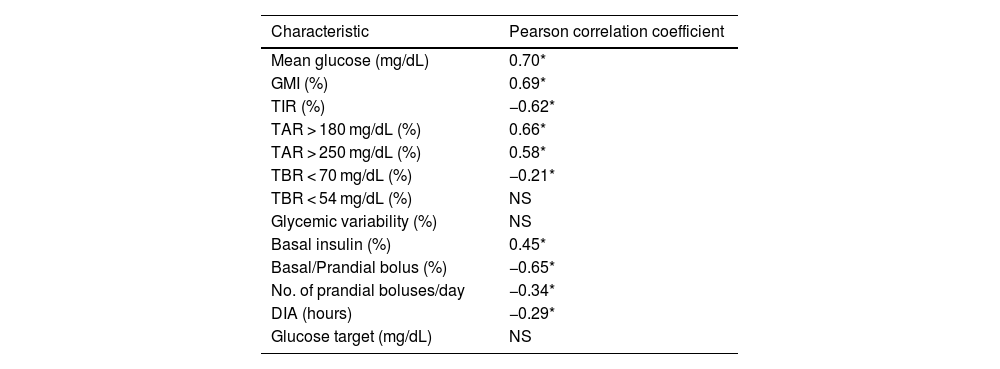The Medtronic MiniMed™ 780G (MM780G) system uses an algorithm that includes autocorrection bolus (AB) delivery. This study evaluates the impact of omitted meal boluses and the system settings, glucose target and active insulin time (AIT), on the AB.
MethodRetrospective observational study on data uploaded by all MiniMed 780G users in our healthcare area, obtained through the remote monitoring platform Care Connect, from April to August 2023. Downloads with a sensor usage time <95% were excluded.
Results235 downloads belonging to 235 users were analysed. AB delivery was significantly higher at 2 h AIT (36.08 ± 13.17%) compared to the rest of settings (2.25–4 h) (26.43 ± 13.2%) (p < 0.001). AB differences based on the glucose target were not found.
Patients with <3 meal boluses per day had higher AB delivery (46.91 ± 19.00% vs 27.53 ± 11.54%) (p < 0.001) and had more unfavourable glucometric parameters (GMI 7.12 ± 0.45%, TIR 67.46 ± 12.89% vs GMI 6.78 ± 0.3%, TIR 76.51 ± 8.37%) (p < 0.001). However, the 2-h AIT group presented similar TAR, TIR and GMI regardless of the number of meal boluses.
ConclusionThe fewer user-initiated boluses, the greater the autocorrection received. The active insulin time of 2 h entails a more active autocorrection pattern that makes it possible to more effectively compensate for the omission of meal boluses without increasing hypoglycaemias.
El sistema Medtronic MiniMed™ 780G (MM780G) utiliza un algoritmo que incluye la administración automática de bolus de autocorrección (BA). Este estudio evalua la influencia de la omisión de bolus prandiales y de los parámetros modificables del sistema, objetivo glucémico y duración de insulina activa (DIA), sobre el BA.
MétodoEstudio observacional retrospectivo sobre las descargas de todos los usuarios del dispositivo MM780G de nuestro área de salud, obtenidas a través de la plataforma de seguimiento remoto Care Connect, de abril a agosto de 2023. Se excluyeron descargas con un tiempo de uso del sensor < 95%.
ResultadosSe analizaron 235 descargas pertenecientes a 235 usuarios. El BA fue significativamente mayor con DIA de 2 horas (36,08% ± 13,17%) frente al resto de duraciones (2,25 - 4 horas) (26,43% ± 13,2%) (p < 0,001). No observamos diferencias del BA en función del objetivo glucémico.
Los pacientes con < 3 bolus prandiales diarios recibían mayor BA (46,91 ± 19,00 % vs 27,53 ± 11,54%) (p < 0,001) y tenían parámetros glucométricos más desfavorables (GMI 7,12 ± 0.45%, TIR 67,46 ± 12,89% vs GMI 6,78 ± 0,3%, TIR 76,51 ± 8,37) (p < 0,001). Sin embargo, el grupo de DIA de 2 horas, presentó similares TAR, TIR y GMI independientemente del número de bolus prandiales.
ConclusiónLa autocorrección es mayor cuanto menos bolus prandiales se administran. La DIA de 2 horas conlleva un patrón de autocorrección más activo que permite compensar más eficazmente la omisión de bolus prandiales sin incremento de hipoglucemias.









